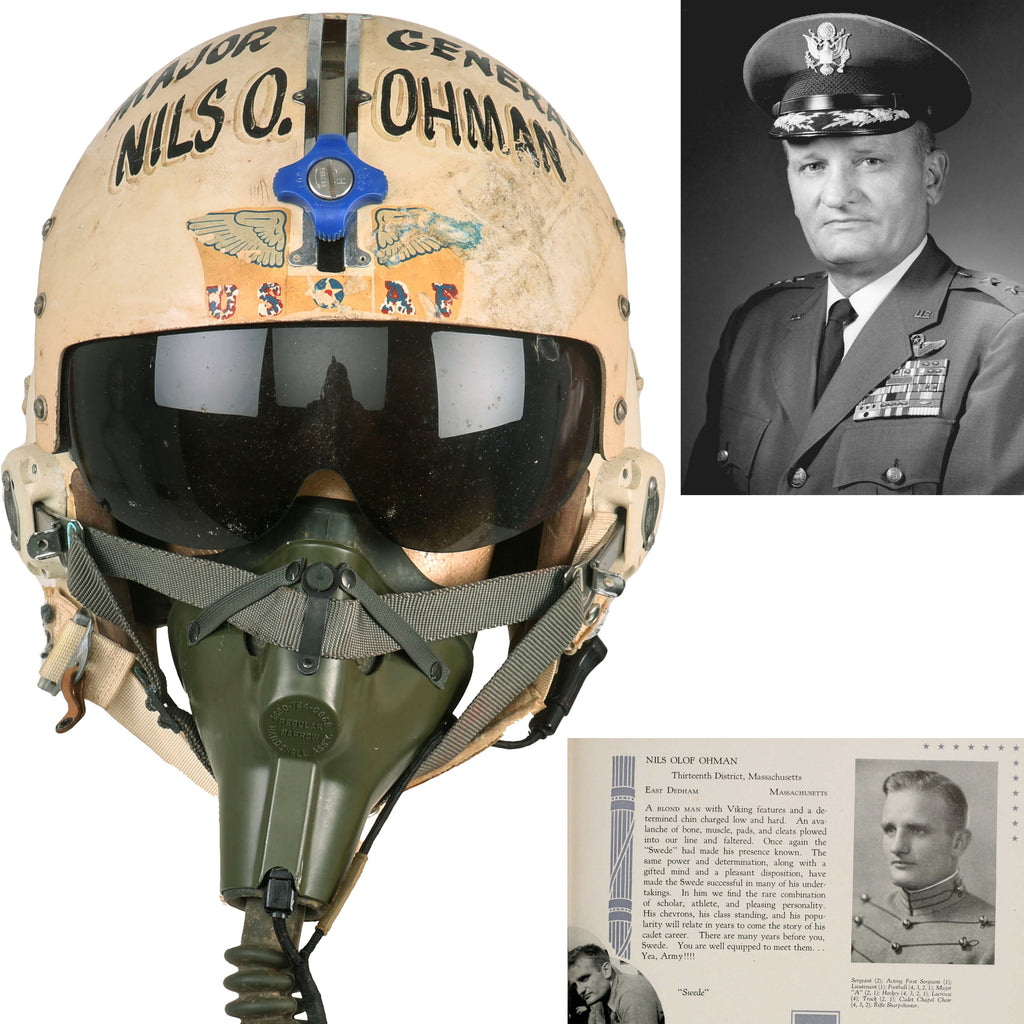Item Description
Original Item: Only One Set Available. This is a wonderful example of an early Vietnam War HGU-2/P Flight Helmet. The helmet is painted on the front visor shield with the name MAJOR GENERAL NILS O. OHMAN. Nils Ohman graduated from the U.S. Military Academy at West Point, Class of 1937. He retired in 1972 as a U.S. Air Force Major General. His military decorations include the Silver Star, Legion of Merit with three oak leaf clusters, Distinguished Flying Cross with two oak leaf clusters, Air Medal with seven oak leaf clusters, Croix de Guerre (France), and Honorary Aviation Badge (Thailand).
This example is in fantastic condition with a great level of wear present. The helmet retains the original tinted visor with locking wheel at the top. From the appearance of the helmet, we do believe it to be complete aside from missing ear pad pieces. The oxygen mask is an MBU-5/P type and is in wonderful used condition.
A great example ready for further research and display.
Biography From 1968
Major General Nils O. Ohman is commander of Headquarters Command, U.S. Air Force, Bolling Air Force Base, Washington D.C.
General Ohman was born in Stockholm, Sweden, in 1914. He graduated from the U.S. Military Academy in 1937, ranking 18th in his class of 298 and was a starting guard on the Army football team. He was named to the all-time Army football squad by the famed "Marty" Maher.
The general received his pilot wings at Kelly Field, Texas, in October 1938 and is a command pilot with more than 7,000 hours of flying time. He has done work in advanced mathematics at Columbia University Graduate School and is the author of several published articles, including "Military Missions" and "Strategic Bombing Concepts."
From August 1965 until his assignment to Headquarters Command, General Ohman served as vice commander, Air Training Command. As vice commander, he assisted, advised, and acted for the commander in managing the activities of Air Training Command's widespread complex of 20 wings, centers, and operating activities, which includes 16 bases.
The general served as deputy chief of staff, Technical Training, Air Training Command from August 1964 until August 1965. In this position, he was responsible for technical training for the U.S. Air Force. This training was accomplished at six bases, 195 field training detachments and 50 mobile training units. The field and mobile units provide technical training for Air Force personnel at stations throughout the world.
From September 1961 to August 1964, General Ohman was senior Air Force member, military studies and liaison, Weapons Systems Evaluation Group, Washington, D.C. Prior to that time he served for nine years as a Strategic Air Command wing and division commander.
General Ohman has served the Air Force around the world. Other assignments have taken him to such widely separated places as Italy, Korea and Washington, D.C. He flew 34 B-17 combat missions in Italy during World War II as commander of the 97th Bombardment Group which destroyed many major strategic targets in the Balkans area and Germany. The general had 46 combat missions in Korea in B-26 and B-29 aircraft and served as commander of the 3rd Bombardment Wing. This wing completely destroyed an enemy division during one night's bombing.
His military decorations include the Silver Star, Legion of Merit with three oak leaf clusters, Distinguished Flying Cross with two oak leaf clusters, Air Medal with seven oak leaf clusters, Croix de Guerre (France), and Honorary Aviation Badge (Thailand).
HGU-2/P
The HGU-2/P and APH-5 were based on the same helmet with the USAF standardizing theirs as the HGU-2/P, the US Navy and US Army had the APH-5 and APH-5A respectively. Just like the US Navy the USAF considered more than one design for replacing the trusty P-helmet series that had served the USAAF and USAF well from 1948 onwards. General Textile Mills appears to have offered a version designated DH-5, very much like the DH-5-3 offered to the US Navy, but in the end the USAF chose the same basic MSA design as the US Navy.
The Navy began their development around 1956 and the USAF assigned the HGU-2/P nomenclature to their version on 15 August 1957 and it was produced in accordance with the military specification MIL-H-26671 dated ???. The HGU-2/P helmet seems to have been fielded from 1959 and differed from the US Navy APH-5 in a few areas. The communications and the oxygen mask tabs are different and so is the colour of the neoprene edgeroll. Identifying features of the HGU-2/P helmet are a heavy helmet shell, often with a poorly painted finish (applies especially to helmets manufactured by Consolidated Components Corp.), thick grey or tan neoprene edgeroll, visor housing with metal strip reinforcement along the visor lock knob track, metal visor tracks, and a three-piece styrene energy absorbing liner. The HGU-2/P is equipped with an H-149/AIC headset identifiable by the MX-2088/U earcups, the double nylon string attachment and the microphone plug hanging loosely from the side of the helmet. Original HGU-2/P helmets came with leather oxygen mask attachment tabs in tan leather with three snaps on each (early USN APH-5 helmets had black tabs with only two snaps on each). Later HGU-2/P helmets were often field modified with Hardman receivers for christmas tree bayonets or cast aluminium receivers for single bayonets. Some were also modified with the three ventilation holes in the crown, often seen as an identifying hallmark of early HGU-2A/P helmet.
- This product is available for international shipping.
- Eligible for all payments - Visa, Mastercard, Discover, AMEX, Paypal & Sezzle



















